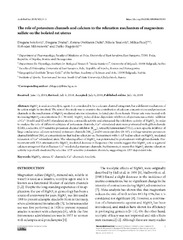Приказ основних података о документу
The role of potassium channels and calcium in the relaxation mechanism of magnesium sulfate on the isolated rat uterus
| dc.creator | Sokolović, Dragana | |
| dc.creator | Drakul, Dragana | |
| dc.creator | Oreščanin Dušić, Zorana | |
| dc.creator | Tatalović, Nikola | |
| dc.creator | Pecelj, Milica | |
| dc.creator | Milovanović, Slobodan | |
| dc.creator | Blagojević, Duško | |
| dc.date.accessioned | 2019-05-30T09:37:48Z | |
| dc.date.available | 2019-05-30T09:37:48Z | |
| dc.date.issued | 2019 | |
| dc.identifier.uri | http://www.doiserbia.nb.rs/Article.aspx?ID=0354-46641800031S | |
| dc.identifier.uri | http://www.serbiosoc.org.rs/arch/index.php/abs/article/view/3064 | |
| dc.identifier.uri | https://radar.ibiss.bg.ac.rs/handle/123456789/3352 | |
| dc.description.abstract | MgSO4 is used as a tocolytic agent. It is considered to be a calcium channel antagonist, but a different mechanism of its action might be involved. The aim of this study was to examine the contribution of calcium concentrations and potassium channels in the mechanism of MgSO4-mediated uterine relaxation. Isolated uteri from female Wister rats were treated with increasing MgSO4 concentrations (0.1-30 mM). MgSO4 induced dose-dependent inhibition of spontaneous activity. Addition of Ca2+ (6 mM and 12 mM) stimulated uterine contractile activity and attenuated the inhibitory activity of MgSO4. In order to analyze the role of different subtypes of potassium channels, Ca2+-stimulated uteri were pretreated with glibenclamide (Glib), a selective ATP-sensitive potassium channel inhibitor (KATP), tetraethylammonium (TEA), a non-specific inhibitor of large conductance calcium-activated potassium channels (BKCa), and 4-aminopyridine (4-AP), a voltage-sensitive potassium channel inhibitor (Kv), at concentrations that had no effect per se. Pretreatment with 4-AP had no effect on MgSO4-mediated relaxation of Ca2+-stimulated uteri. The relaxing effect of MgSO4 was potentiated by pretreatment with glibenclamide. Pretreatment with TEA attenuated the MgSO4-mediated decrease in frequency. Our results suggest that MgSO4 acts as a general calcium antagonist that influences Ca2+-mediated potassium channels. Furthermore, it seems that MgSO4 uterine relaxation activity is partially mediated by selective ATP-sensitive potassium channels, suggesting an ATP-dependent role. | en |
| dc.relation | info:eu-repo/grantAgreement/MESTD/Basic Research (BR or ON)/173014/RS// | |
| dc.rights | openAccess | |
| dc.rights.uri | https://creativecommons.org/licenses/by-nc-nd/4.0/ | |
| dc.source | Archives of Biological Sciences | |
| dc.subject | Ca2+ channels | |
| dc.subject | K+ channels | |
| dc.subject | MgSO4 | |
| dc.subject | Tocolytic | |
| dc.subject | Uterus | |
| dc.title | The role of potassium channels and calcium in the relaxation mechanism of magnesium sulfate on the isolated rat uterus | en |
| dc.type | article | en |
| dc.rights.license | BY-NC-ND | |
| dcterms.abstract | Благојевић, Душко; Соколовић, Драгана; Дракул, Драгана; Таталовић, Никола; Орешчанин Душић, Зорана; Пецељ, Милица; Миловановић, Слободан; | |
| dc.rights.holder | © 2019 by the Serbian Biological Society | |
| dc.citation.issue | 1 | |
| dc.citation.volume | 71 | |
| dc.identifier.doi | 10.2298/ABS180615031S | |
| dc.identifier.scopus | 2-s2.0-85065486383 | |
| dc.identifier.wos | 000463592100001 | |
| dc.citation.apa | Sokolović, D., Drakul, D., Oreščanin-Dušić, Z., Tatalović, N., Pecelj, M., Milovanović, S., et al. (2019). The role of potassium channels and calcium in the relaxation mechanism of magnesium sulfate on the isolated rat uterus. Archives of Biological Sciences, 71(1), 5–11. | |
| dc.citation.vancouver | Sokolović D, Drakul D, Oreščanin-Dušić Z, Tatalović N, Pecelj M, Milovanović S, Blagojević D. The role of potassium channels and calcium in the relaxation mechanism of magnesium sulfate on the isolated rat uterus. Arch Biol Sci. 2019;71(1):5–11. | |
| dc.citation.spage | 5 | |
| dc.citation.epage | 11 | |
| dc.type.version | publishedVersion | en |
| dc.identifier.fulltext | https://radar.ibiss.bg.ac.rs//bitstream/id/5036/ABS-71-1-005-011.pdf | |
| dc.citation.rank | M23 |

